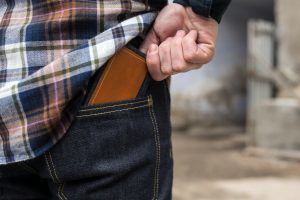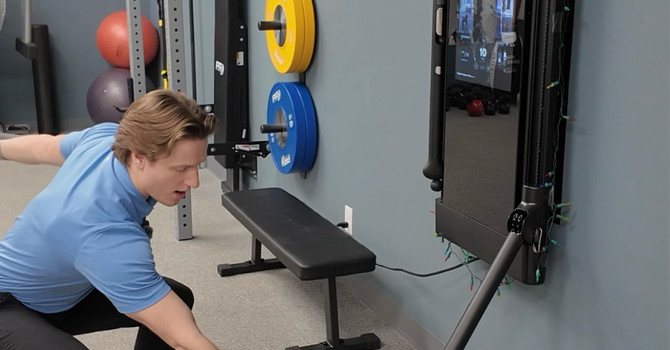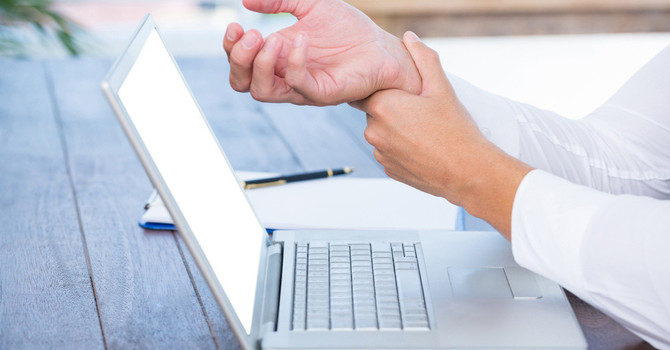
“Purses are for girls, and back pockets are for boys.”
If you grew up with this train of thought for how to carry your wallet, then you might also know it’s a tough habit to break.
Yet, despite being taught that wallets go into our bags or back pockets, we weren’t told that stashing our stuff could be bad for our backs or joints. Who knew that sitting on a bunch of folded bills or stashing coins and lip balm in a shoulder bag can wind up causing aching shoulders, back, and neck pain?
Rather than teach us how to live better, we had consumerism marketing masquerading as advice. The result: new purses were bought to help alleviate shoulder pain, and new jeans were purchased whenever the back pocket wore out.
How does using a purse or sitting on my wallet affect me?
Carrying heavy shoulder bags, sitting with a wallet in your back pocket, and even heavy backpacks have one major consequence in common: lopsided posture. Slipping your wallet into the back of your jeans or into your shoulder bag (which can also carry emergency bandages, spare pens, and the weight of a thousand other things to do) causes uneven weight distribution on the spine, hips, and shoulders. Sitting with one hip higher than the other due to the bulk of a wallet creates a lopsided tilt of the pelvis or the sitting bones. Something similar happens with a heavy purse: lopsided weight is consistently carried on one shoulder, weighing down one side compared to the other.
A result is a person sitting lopsided with a rounded, banana-shaped spine. This hunch-like position puts more stress on the back and spine and can even cause a slouchy posture with slumped shoulders. Muscles work harder to compensate, and joints become stiff and achy.
Sitting on a wallet or carrying a shoulder bag can also affect the nerves of our body. Carrying a heavy bag over the shoulder can strain the muscles and nerves of the neck in an area called the brachial plexus. Pinched nerves in this area can result in tingling and numbness down the arm, into the hand, and to the fingertips.
A similar effect happens from sitting on a wallet: the sciatic nerve gets pinched between your wallet, your gluteal muscles, and your hip. Even after a short time, the sciatic nerve can become irritated, causing discomfort that ‘zings’ down the back of the leg and into the heel. This condition is so commonplace that it has earned the nickname, “wallet neuritis,” describing the inflammatory response that happens to the sciatic nerve due to sustained compression.
Even the thinnest wallet and lightest of shoulder bags can create these symptoms.
What can I do about it?
If you love your wallet or carrying a bag, however, all is not lost! Some simple changes in your daily routine will help you keep using your cute clutch, nifty clip, or the leather wallet you received as a birthday gift.
If you must carry a bag, keep it to just the essentials: pare down your carrying case to make it more lightweight. If you can, invest in a bag with a wide-banded strap that crosses diagonally over the torso. This design helps balance weight between your shoulder blades, chest, and pelvis, and even helps prevent theft by making your bag harder to steal. Consider switching to lighter gauge materials such as nylon, long-strand cotton, or canvas that are also durable with wear and functional to use. At the very least, alternate shoulders to prevent one side from maintaining the bulk of the weight.
Waist bags (or fanny packs as some call them) are fantastic to avoid the shoulder region altogether. Plus, there are many fashionable styles that are also functional!
For wallet users, your best bet is to remove it from your back pocket entirely before you sit down or get in your car. You could switch your wallet to your front pocket – but be warned that prolonged use of a wallet in this position can also pinch a nerve between the thigh and torso, especially when you’re in a car. This can create discomfort as well.
While at work, place the wallet in your desk, locker, or somewhere safe. You should also avoid anything bulky and stick to slim wallets or money clips that hold only the essentials.
The bare minimum advice is to alternate back pockets to carry your wallet if you must use the back pocket to carry your wallet (or a similar object) at all. This helps evenly distribute the lopsidedness when sitting as well as wear-and-tear on your pants.
What if that’s not enough?
We can take care of you in our Boca Raton Sports Chiropractic practice. We perform a detailed history of your injury, followed by a functional movement assessment and examination.
If you have been carrying a purse or sitting on your wallet for many years, this may be a cause of shoulder pain, low back pain, and even pelvic imbalances. We recommend scheduling a chiropractic visit to evaluate any muscle aches, imbalances, or joint problems you may have. We can help identify postural compensations or spinal fixations that result from wallet and shoulder bag ergonomics and provide other alternatives to keep you functioning, feeling great, and your belongings safely stowed where you need them.
References
1. Siddiq, M., Jahan, I., & Masihuzzaman, S. (2018). Wallet Neuritis - An Example of Peripheral Sensitization. Current rheumatology reviews, 14(3), 279–283.
2. Lutz, E.G. Credit-card-wallet sciatica. JAMA. 1978;240(8):738.
3. Viggiani, D., Noguchi, M., Gruevski, K.M., Carvalho, D.D., and Callaghan, J.P. The Effect of Wallet Thickness on Spine Posture, Seat Interface Pressure, and Perceived Discomfort During Sitting. IISE Transactions on Occupational Ergonomics and Human Factors. 2014;2:83–93.
4. “Heavy backpacks and children.” Southwest Scoliosis Institute. Retrieved from https://scoliosisinstitute.com/heavy-backpacks.
5. Rempel, D.M., and Diao, E. Entrapment neuropathies: pathophysiology and pathogenesis. J. Electromyogr. Kinesiol. 2004;14(1):71–75.
6. Mwaka, E.S., Munabi, I.G., Buwembo, W., et al. Musculoskeletal pain and school bag use: a cross-sectional study among Ugandan pupils. BMC Res Notes 7, 222 (2014).
7. Amyra Natasha, A., Ahmad Syukri, A., Siti Nor Diana, M. K., Ima-Nirwana, S., & Chin, K. Y. (2017). The association between backpack use and low back pain among pre-university students: A pilot study. Journal of Taibah University Medical Sciences, 13(2), 205–209.



